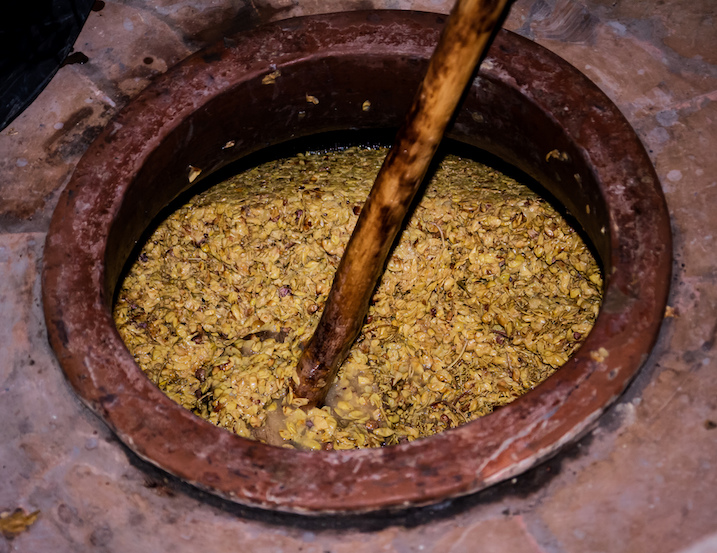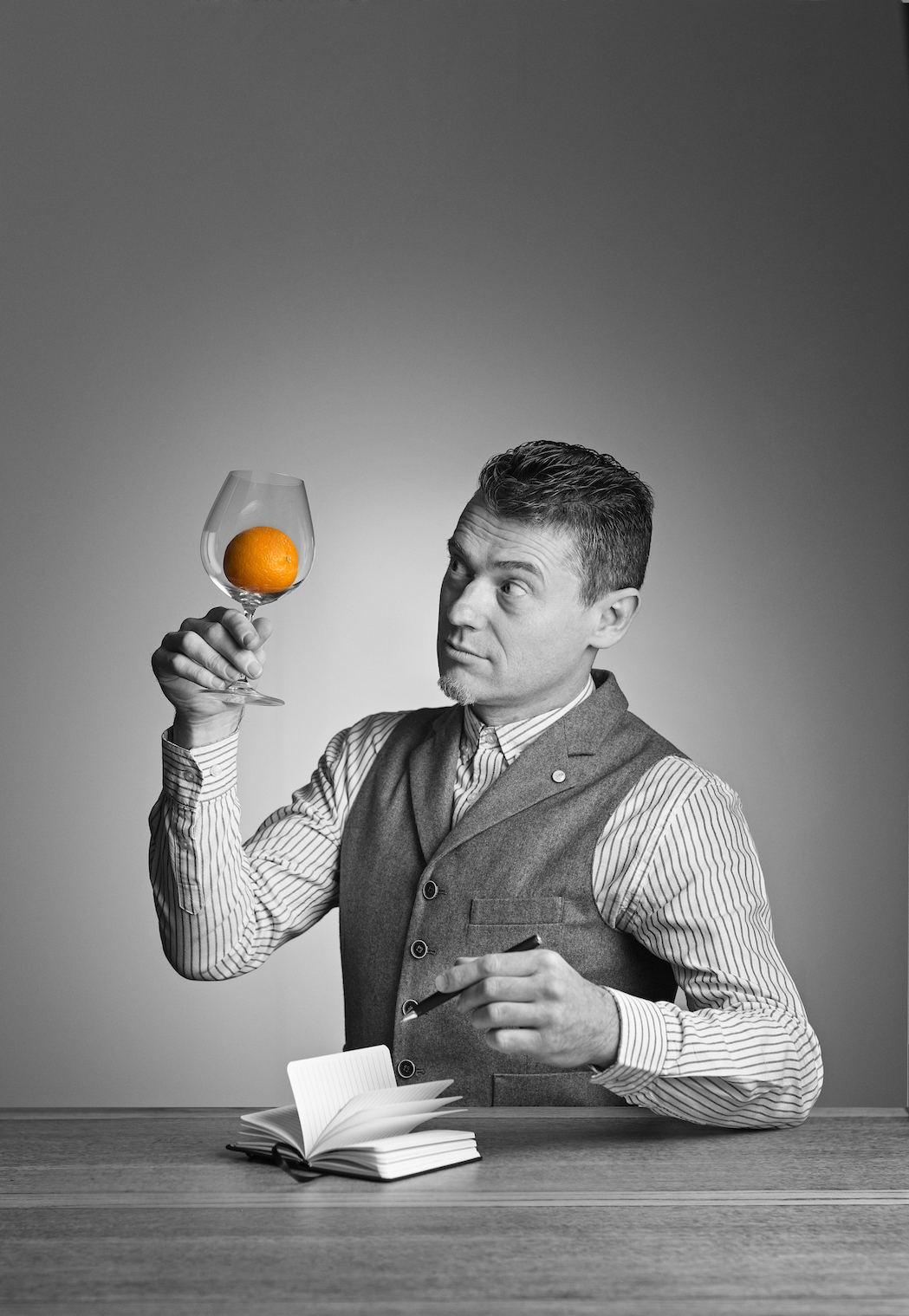Award winning writer, natural wine expert and Decanter contributor Simon J Woolf today announced the launch of his first book Amber Revolution. Subtitled “How the world learned to love orange wine”, Woolf describes the book as “The rags to riches story of the world’s oldest and most unique wine style, as gripping as a good novel”.
Amber Revolution is the result of over four years of research, covering post-war Friuli and neighbouring Slovenia, joining the dots to Georgia’s traditional wine culture, the 8,000 year old origin of orange wine. The 250 page book profiles 180 top orange wine producers, and is illustrated with more than 100 beautiful shots from photographer Ryan Opaz.
Support Simon’s Kickstarter campaign for Amber Revolution HERE and watch the video HERE.
We sat down with Simon recently for a chat about all things amber. Here’s what he had to say:
Orange, amber, skin contact – (or other) – what should we call these wines?
“Orange wine” is by far the most popular term for these wines, whether one likes it or not – just as “natural wine” has become the accepted term for minimal intervention, whether one likes it or not. In my opinion, it’s mere folly to confuse people with other nomenclature, even if it might be more elegant or more accurate.
One sentence definition of amber wine?
White wines made with long skin maceration (days/weeks/months) during fermentation.
Tell us about your new book
The book is called Amber Revolution. I couldn’t bring myself to put the word “orange” in the title, because we were at the height of the US presidential election, and the colour orange has the most unwelcome associations possible.
Amber Revolution is structured and written like a novel. The protagonists are struggling winemakers in an obscure cross border region straddling the ex-Austro-Hungarian empire. Through their quest for authenticity, they discover an ancient winemaking method, almost forgotten and completely out of fashion. It ends up propelling them and their region to fame, if not fortune!
The book tells their story and links it to the also almost forgotten traditional winemaking culture in Georgia.
Along the way, we learn about how this wine is made, why it tastes different and how best to enjoy it.
Finally, there’s a kind of gazetteer which profiles 180 winemakers around the globe who specialise in the style. I’m not listing people who’ve “had a go” at making an orange wine, but rather those who have really invested in the style and have a few years of experience with it.
Some “orange” wines are made by slow pressing in the presence of lots of oxygen (eg Didier Barral’s white). Are these different?
In my opinion this comes from a completely different tradition of oxidative winemaking, and is not related to what I would see as the “classic” orange wine traditions of Friuli Collio, Goriska Brda and Kakheti. Then again, there is space for different winemaking techniques within the “white”, “red” and “rosé” categories so maybe we have to think about this in a different way.
Describe the spectrum of colours that one may find in skin contact wines?
This is one of the great joys. In no other wine style does one find such a range of beauty, from light gold, to deep amber, rusty orange and russet brown – not to mention the lurid pink of skin contact Pinot Grigio.
What is it that gives the wines their particular hues? And why are they different?
The differences are mostly down to the grape variety and the winemaking. Of course, the duration of the skin contact makes a difference, but not as much as one might think.
Many white varieties have amazing pigments locked up in their skins, and given enough extraction (punchdowns etc) the colour can be breathtaking. Dario Prin?i?’s wines spring to mind!
What qualities does the wine derive from skin contact?
Depth and complexity of flavours which just don’t exist in non- macerated white wines, and of course structure. The tannic component is very important in orange wines – just as with red wines, it helps freshen the palate and balance out the fruit.
Also, colour, and last but not least, stability – all those phenolic compounds help preserve the wine from oxidation.

Some say that skin maceration obviates terroir expression? Or that the wines begin to taste the same? What do you say?
When people trot this old chestnut out, I usually ask if they feel that red wines lack terroir or varietal expression. After all they’re made in exactly the same way!
In truth, any winemaking technique, be it malolactic fermentation, ageing in oak or battonage can obscure origin – but terroir in the most complete sense does include tradition and winemakers, I would say. So a dense, meaty Ribolla with a month or more of skin contact is to me the perfect terroir expression of Friuli Collio, whereas the aromatic, flirtatious skin contact Traminers coming out of Burgenland and Styria are quite obviously different.
Ultimately, it comes down to this: People who don’t like rap or hip-hop say it all sounds the same. People who don’t like Woody Allen’s films say it’s always the same kvetsching dialogue. People who don’t know anything about wine say it all tastes the same.
It’s about getting comfortable with a style, and exploring it enough to be able to notice the nuances and pick out the different characters.
Does skin contact work better with certain grape varieties? Which ones are best and why? Are there grape varieties where it doesn’t work so well? Or is it more about the quality of grapes?
There are certainly classics of the genre – Ribolla Gialla is the whole reason we’re here. Super thick skins, and a paucity of primary fruit flavours make it perfect for long maceration.
Aromatic varieties such as the Muscat and Traminer families seem to do well – but their aromatics are often accentuated, not muted, by the skin contact, so it can get out of hand with something like Gewurz.
I’ve had numerous Chardonnays and Sauvignon Blancs which generally work very well. This appears to suggest that a quality variety is a quality variety, whatever the treatment.
In general, I’d say good acidity is a must. It’s so important to balance the complexity of flavours. I’ve yet to taste an orange wine made from Palomino Fino, and I think there’s probably a reason for that!
Sensitivity towards the raw material is important: if you have delicate Torrontes grapes with pretty aromas, do you really want to turn that into a big, burly orange monster?
Some macerated wines give intense colour after just a few days, whereas others can be on skins for months and not feel extractive – discuss.
As above – a lot depends on the variety and the specifics of the winemaking. Temperature has a part to play. I’m no scientist but as far as I’m aware, higher temperature, uncontrolled ferments will tend to pick up colour from the anthocyanins much faster.
How would you describe the texture in the mouth of skin contact wines?
There’s a huge range, from some, where you’d barely know there’d been any skin contact, to those which coat the mouth with tannins and are practically a meal in themselves. Young qvevri-fermented Mstvane for example!
Most (all?) of skin contact wines goes through malo. The sensation of acidity seems low in the palate. How important is bitterness in the balance of the wine?
That’s why it’s important to start with excellent levels of acidity! But again, I find that balance in these wines can be more similar to reds – you need the acidity, but structure and tannins really helps too.

Can skin contact wines be refreshing? Or are they too ‘substantial’ and textural?
They span the whole gamut. I’ve had plenty that I’d describe as refreshing. With less skin contact and earlier harvesting, the end result can be spine-tinglingly fresh and electric – the Schmeck das Leben guys (Muster, Tscheppe, Strohmeier, Tauss, Werlitsch) are very good at this, as is Angiolino Maule.
Can you give us a brief biography of skin contact wines? Where were wines in this style first being made?
We can prove that this was a popular style all around the Adriatic from at least as far back as the early 1800s. In Georgia, we know that qvevris were used to make wine as far back as 6,000BC. However, these two separate traditions didn’t really link up until Gravner joined the dots in 2000.
In Italy and Slovenia, the style died out after WWII, as new winemaking technology swept the nation, starting in Friuli. Suddenly everyone wanted crystal-clear, water-white varietals that were fresh and lively – a style that barely existed before stainless tanks and temperature control became available.
When did the revival happen? What was the opinion of critics (and customers) of what the growers were doing?
Radikon and Gravner released their first vintages with long skin contact in 1998. Both told me they had half their orders sent back. The entire Italian wine trade thought they’d gone mad – these were famous, well-regarded estates, not tearaways. But they stuck to their guns until people understood the new style, and of course they found new customers! The proof is in how many other winemakers they’ve since influenced.
We are seeing lots of fantastic amber wines from Italy, Austria, Slovenia and Spain, in particular, but curiously few from France still. Why do you think that is?
It’s a good question. There are plenty of people in Languedoc Roussillon and the south making them, including some cult names (Viret, Domaine Gauby, Matassa), but for me they rarely scale the heights. Perhaps it’s the lack of acidity – Grenache Blanc can tend towards flabbiness in this style.
The growth of skin contact wines seems to have gone hand-in-hand with the growth of the artisan/natural wine movement? Is that a fair observation?
Yes, they’re pretty closely connected. Radikon started, after all, with the goal of being additive free and as sustainable as possible. Gravner has always had similar aims. That said, we’re now seeing a much greater variety of wineries having a go with the style – with varying degrees of success.
Besides skin maceration are there certain common vinification techniques in making amber wines?
Use of natural yeasts, very frequent punchdowns (as many as 5 or 6 a day), and no temperature control are probably the most important.
Do skin macerated wines normally have less SO2 added? Why?
Generally, yes. Phenolics/tannins give a wine strength, so just as red wines normally need much less than whites, skin macerated wines can also make do with less. Furthermore, they’re usually left to ferment slowly to dryness, so there’s little risk of residual sugar or refermentation.
Describe matching skin contact wines with food. Are they versatile? Why?
Super versatile. You’ve got some of the freshness of a white wine, together with the structure of a red. As Levi Dalton once remarked, they’re a great ‘get out of jail free card’ when confronted with a difficult food match. I’ve had great results with every kind of meat, spicy and Asian cuisine; everything really. There’s such a huge range even within ‘Orange’.
How would you serve an amber wine? (ie carafe, type of glass, temperature…)
No colder than 12C, and perhaps considerably warmer for the bigger, heavier wines with more skin contact. I find a large bowled glass works well – a Pinot Noir glass, for example. Carafing can be good for younger wines – I wouldn’t say it’s vital.
Some people bottle with the lees, some like to shake the wine before opening and mix it all together, others don’t. It’s a matter of taste, and how much cloudiness you want!

What was the first amber wine you tried? What did you think?
It was probably something from Elisabetta Foradori. I don’t remember disliking it, but I tasted it in a WSET classroom in London and I was just rather puzzled – I had no context for it. The first one that blew me away was Sandi Skerk’s Ograde, tasting in his cellar in 2011.
What is the best way to sell an amber wine on a wine list? Should the wine(s) have a separate section?
Without question. No-one lists rosés with reds, nor should oranges be listed with whites. They’re different in so many ways, customers need to be aware of what they’re ordering. Labels don’t help in this respect, as so many orange wines are still sold technically as “Vino Bianco” which is crazy.
Which restaurants do a particularly good job?
I have to mention Sager + Wilde and The Remedy – two of the best orange lists I’ve seen anywhere in the world; well signposted and selected. If I mention Terroirs there’ll be cries of nepotism I suppose!
The Neptune seafood cafe in Piran, Slovenia was one of the first places I ever saw a separate orange list. It’s small but classic (Radikon features, among others).
Here in Amsterdam, Choux is probably the premiere place to go and drink a glass of something orange. Figo always has something fun up his sleeve.
I get the impression that wine writers and critics harbour an antipathy about amber wines (judging by what I read and also the amount of eye-rolling when I talk about them). Why do you think this is? (To be fair, we could have had the same debate about filtered versus unfiltered wines twenty years ago).
Most of it is misunderstanding and fear of the unknown. And, of course, there are some badly made wines out there which do put people off. We’re already seeing classics emerge in the orange sector – Hugh Johnson was already familiar with Gravner, and greatly enjoyed the bottle I opened for him.

You showed some orange wines to Hugh Johnson not so long ago. What was his opinion prior to that and did he change his mind?
To be perfectly honest, he didn’t have a clear definition of what orange wine is. Like so many, he’d muddled up orange wine with natural wine, and it was the latter that occupied most of his frustrations. I wouldn’t say I changed his mind, but I hope I helped him pin down the category and showed him how vibrant the orange wine sector is. He thanked me for challenging him!
Three amber wines for beginners?
Elisabetta Foradori – Nosiola Fontanasanta 2014
The Supernatural Wine Co – Green Glow 2015
Andreas Gsellmann – Traminer 2015
Three for advanced students?
Cos – Pithos Bianco 2014
La Stoppa – Ageno 2011
Strohmeier – Wein der Stille 2013
Finally, what is the future for skin contact wines? Some commentators say that they are merely a fad, yet we are seeing growers in every wine producing country either experimenting with (or fully espousing) this style of winemaking. Will amber be the fourth colour on wine lists?
It already is! There are so many high-end restaurants, or restaurants in regions of production that have their orange lists now. And it’s unbelievable to see how many wineries now want in on the style. Only the other day I was talking to Tony Milanowski at the Plumpton winemaking college in the UK – he’s put skin contact winemaking on the syllabus, and they are about to install a qvevri cellar.
Orange will claim its place as an established and important niche, and as another technique available to winemakers – it’s never going to line supermarket shelves, but then neither do Vin Jaunes, Georgian qvevri wines or German trockenbeerenauslesen.

Read more about Simon and support his Kickstarter campaign!
Simon Woolf is an award-winning English wine and drinks writer, currently clinging to mainland Europe in Amsterdam. He’s obsessed with orange wine and well-known for his writing on all things natural, organic and biodynamic.
Simon is a columnist for palatepress.com and contributes regularly to Decanter and Meininger Wine Business International. He’s also written for Punch Drunk, Jancis Robinson, timatkin.com, Harpers online and Catavino.net amongst others.
When not writing about wine, he is a keen amateur cook, lover of sour beers, cats and obscure music that no right-thinking person would find acceptable.



